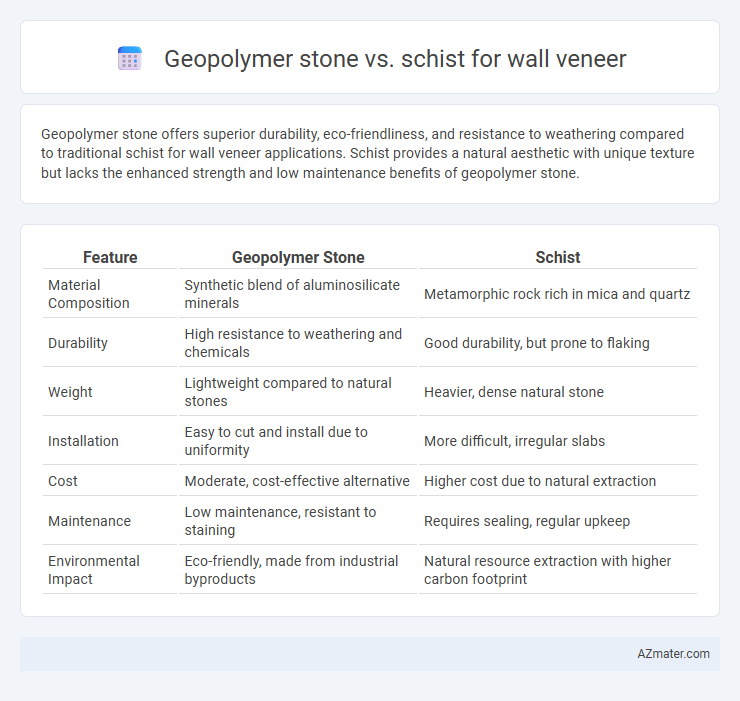Geopolymer stone offers superior durability, eco-friendliness, and resistance to weathering compared to traditional schist for wall veneer applications. Schist provides a natural aesthetic with unique texture but lacks the enhanced strength and low maintenance benefits of geopolymer stone.
Table of Comparison
| Feature | Geopolymer Stone | Schist |
|---|---|---|
| Material Composition | Synthetic blend of aluminosilicate minerals | Metamorphic rock rich in mica and quartz |
| Durability | High resistance to weathering and chemicals | Good durability, but prone to flaking |
| Weight | Lightweight compared to natural stones | Heavier, dense natural stone |
| Installation | Easy to cut and install due to uniformity | More difficult, irregular slabs |
| Cost | Moderate, cost-effective alternative | Higher cost due to natural extraction |
| Maintenance | Low maintenance, resistant to staining | Requires sealing, regular upkeep |
| Environmental Impact | Eco-friendly, made from industrial byproducts | Natural resource extraction with higher carbon footprint |
Introduction to Geopolymer Stone and Schist
Geopolymer stone is a synthetic material made from industrial byproducts like fly ash and slag, known for its high durability, low environmental impact, and excellent resistance to weathering, making it ideal for wall veneer applications. Schist, a natural metamorphic rock, features a foliated texture with visible mineral grains, offering unique aesthetic appeal and moderate durability but requiring careful sealing to prevent moisture absorption. Both materials provide distinct advantages for wall veneers, with geopolymer stone favored for sustainability and uniformity, while schist appeals for natural beauty and texture.
Composition and Origin
Geopolymer stone is an engineered material composed primarily of aluminosilicate compounds derived from industrial byproducts like fly ash and slag, cured through a chemical process that mimics natural rock formation. Schist, a metamorphic rock, originates from the metamorphism of sedimentary rocks under intense heat and pressure, characterized by its foliated texture dominated by mica minerals. The synthetic nature of geopolymer stone allows for consistency and customization, while schist's natural formation results in unique mineral patterns and variations.
Aesthetic Appeal and Design Versatility
Geopolymer stone offers a consistent texture and customizable color palette, making it highly versatile for modern and contemporary wall veneer designs. Schist provides a natural, rugged aesthetic with its layered, shimmering surface that enhances rustic and traditional interiors. Both materials deliver unique visual appeal, but geopolymer stone allows for greater design flexibility due to its engineered uniformity and wide range of finishes.
Durability and Weather Resistance
Geopolymer stone exhibits superior durability and weather resistance compared to schist, making it an excellent choice for wall veneer in harsh environments. Its synthetic mineral composition provides enhanced resistance to moisture, freeze-thaw cycles, and UV radiation, reducing the risk of cracking and spalling over time. Schist, while naturally attractive, is prone to weathering and surface degradation due to its foliated structure and mineral composition, which can lead to reduced longevity in exterior applications.
Environmental Impact and Sustainability
Geopolymer stone offers a significantly lower environmental impact compared to schist, as it is manufactured using industrial byproducts like fly ash and requires less energy-intensive processing, thereby reducing carbon emissions. Schist, a natural stone, involves extensive quarrying that can lead to habitat disruption and higher transportation emissions due to its weight and mining locations. The sustainability advantages of geopolymer stone include recyclability and the use of waste materials, making it a more eco-friendly option for wall veneer applications focused on reducing ecological footprint.
Installation Process and Labor Requirements
Geopolymer stone offers a lightweight and uniform material that simplifies the installation process, requiring less skilled labor and reducing overall labor time compared to natural schist. Schist, with its natural variation in thickness and irregular shapes, demands more precise cutting, fitting, and greater labor expertise for wall veneer applications. The consistent size and texture of geopolymer stone allow faster adhesion and alignment, enhancing installation efficiency and lowering labor costs.
Cost Comparison
Geopolymer stone offers a cost-effective alternative to natural schist for wall veneer, with prices typically 20-30% lower due to lower material and manufacturing expenses. Schist, a natural metamorphic rock, tends to be more expensive because of quarrying, transportation, and processing costs, which can vary widely by region. Long-term, geopolymer stone provides budget-friendly installation and maintenance, making it an economical choice for large-scale or budget-conscious wall veneer projects.
Maintenance and Longevity
Geopolymer stone offers superior durability and low maintenance due to its resistance to weathering, staining, and erosion, making it ideal for long-lasting wall veneers. Schist, a natural metamorphic rock, requires periodic sealing and is more susceptible to chipping and moisture absorption, which can lead to higher maintenance over time. The synthetic nature of geopolymer stone ensures consistent performance and longevity compared to the variable properties of schist.
Popular Applications in Wall Veneers
Geopolymer stone offers high durability and resistance to weathering, making it ideal for exterior wall veneers in commercial and residential buildings. Schist, valued for its natural texture and layered appearance, is commonly used for decorative interior wall veneers and accent walls. Both materials provide unique aesthetic appeal, with geopolymer stone favored for modern architectural designs and schist preferred in rustic or traditional settings.
Choosing the Right Material: Geopolymer Stone vs Schist
Geopolymer stone offers superior durability, low porosity, and environmental sustainability compared to natural schist, making it ideal for wall veneer in areas exposed to harsh weather or requiring low maintenance. Schist provides a natural, textured appearance with unique mineral patterns, but it is more susceptible to weathering and requires periodic sealing to preserve its aesthetic and structural integrity. Selecting between geopolymer stone and schist depends on prioritizing long-term durability and eco-friendliness or authentic natural beauty and traditional appeal for wall cladding projects.

Infographic: Geopolymer stone vs Schist for Wall veneer
 azmater.com
azmater.com